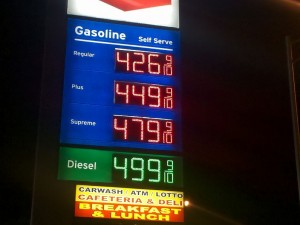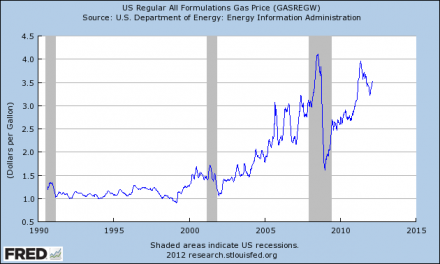 If violent crime rates are surging, should the police get more funding or less funding? You would think that the answer should be obvious, but unfortunately major cities all over the nation are choosing to significantly reduce police budgets right now. With less police on the streets, criminals are going to have even more freedom to terrorize urban communities, and that will likely accelerate the mass exodus out of our major cities that we have already been witnessing. It is so sad to watch so many of our once great cities degenerate into crime-ridden, gang-infested war zones, and the fact that our economy is crumbling so rapidly is just going to make things even worse.
If violent crime rates are surging, should the police get more funding or less funding? You would think that the answer should be obvious, but unfortunately major cities all over the nation are choosing to significantly reduce police budgets right now. With less police on the streets, criminals are going to have even more freedom to terrorize urban communities, and that will likely accelerate the mass exodus out of our major cities that we have already been witnessing. It is so sad to watch so many of our once great cities degenerate into crime-ridden, gang-infested war zones, and the fact that our economy is crumbling so rapidly is just going to make things even worse.
Let me illustrate what I am talking about by giving you some specific examples. In Seattle, the city council just voted to reduce the police budget by 69 million dollars…
The city council voted last week to slash about $69 million in funding for officer training, salaries and overtime, and get rid of vacant positions in the police department as well as transfer parking officers, mental health workers, and 911 dispatchers out of the department. The goal is to ultimately reinvest in alternatives to police in situations such as mental health crises.
Of course this comes at a time when crime rates have been steadily rising in the city. In fact, there have already been more than 8,400 reported burglaries so far this year…
Meanwhile, Seattle had seen 55 murders this year as of Monday, the highest level since at least 2008, the last year of data available. The troubled city is also suffering a spike in violent crime, with 8,418 burglary incidents, up from to 7,634 last year, according to police.
In New Orleans, police funding is being reduced by 11 million dollars and a new furlough policy is causing many officers to leave the force entirely…
New Orleans Police Chief Shaun Ferguson says as he deals with rising homicide and carjacking rates, the city’s furlough policy is causing him to lose officers.
The NOPD is being forced to take an $11 million budget cut in the year ahead.
Meanwhile, homicides are up 60 percent this year, and carjackings are up “more than 100 percent”…
He told the city council that most of those who left last week blamed city imposed furloughs that cause officers to lose two days of pay each month. The furloughs come as the city deals with a 60 percent rise in homicides and a more than 100 percent jump and carjackings.
In Minneapolis, the politicians are still squabbling about how much they want to take out of the police budget…
Minneapolis Mayor Jacob Frey and Police Chief Medaria Arradondo on Monday rebuffed a proposal by three City Council members to cut the Minneapolis police budget by nearly $8 million, with Frey calling the plan “irresponsible and untenable” amid a year of rising violent crime and a shrinking police force.
Why they would want to take any money away from the police is a mystery, because carjackings in the city are up a whopping 537 percent in 2020…
Within a one-hour period Saturday morning, police reported three separate carjackings in southeast Minneapolis, including one where an elderly woman was struck on the head. The often brazen, daytime attacks are up 537% this month when compared with last November, said police spokesman John Elder.
If carjackings are up 537 percent, your city is officially out of control. I have relatives that live in Minneapolis, and it has been heartbreaking to watch what has happened to a city that was once so peaceful.
In Los Angeles, the police budget was slashed by 150 million dollars this year.
Yes, you read that correctly.
Is it just a coincidence that people are now being gunned down all over the place in many parts of the city?…
Killings are up 25% over last year and shootings are up more than 32%, mirroring increases in violence that are driving concerns in big cities across the nation. Last week, a pregnant woman was gunned down. Children and elderly residents have been killed. Of all the year’s victims, nearly 20% have been homeless. Gangs are suspected in many cases.
I could go on and on, but I think that you get the point.
In this sort of an environment, an execution in broad daylight that is captured on camera barely makes a blip in the news…
New Jersey-based rapper Tripple Beanz was walking to his SUV in Newark on Friday when he was confronted by two masked gunmen and shot dead execution-style in broad daylight.
The cold-blooded killing of the 29-year-old recording artist, born Corey Thompson, was caught on surveillance video, which showed his attackers fire multiple shots at the victim as he rolled on the ground.
Why didn’t Corey Thompson’s death get much attention from the media?
It is because people are being gunned down all over the country on a constant basis. It has become so common that such incidents are no longer newsworthy.
And those that have read my new book already know that the violence is only going to escalate in the years ahead.
100 years ago, young people in America didn’t act like this, and that is because they were raised much differently.
When you put garbage in, you are going to get garbage out. We have filled the minds of our kids with the most horrible things you can imagine, and it gets worse with each passing year.
A lot of people think that “education” is the answer, but our schools are some of the biggest offenders when it comes to corrupting young minds. In fact, it is being reported that administrators all over the country are now spending enormous mountains of money to promote the “woke agenda” in our public schools.
In a society that is starting to spiral out of control, a strong police presence is more necessary than ever before.
Unfortunately, those on the radical left will continue to push to defund the police no matter how high crime rates go.
This is going to have disastrous consequences from coast to coast, and many of our major cities will never be the same again.
***Michael’s new book entitled “Lost Prophecies Of The Future Of America” is now available in paperback and for the Kindle on Amazon.***
About the Author: My name is Michael Snyder and my brand new book entitled “Lost Prophecies Of The Future Of America” is now available on Amazon.com. In addition to my new book, I have written four others that are available on Amazon.com including The Beginning Of The End, Get Prepared Now, and Living A Life That Really Matters. (#CommissionsEarned) By purchasing the books you help to support the work that my wife and I are doing, and by giving it to others you help to multiply the impact that we are having on people all over the globe. I have published thousands of articles on The Economic Collapse Blog, End Of The American Dream and The Most Important News, and the articles that I publish on those sites are republished on dozens of other prominent websites all over the globe. I always freely and happily allow others to republish my articles on their own websites, but I also ask that they include this “About the Author” section with each article. The material contained in this article is for general information purposes only, and readers should consult licensed professionals before making any legal, business, financial or health decisions. I encourage you to follow me on social media on Facebook, Twitter and Parler, and any way that you can share these articles with others is a great help. During these very challenging times, people will need hope more than ever before, and it is our goal to share the gospel of Jesus Christ with as many people as we possibly can.








